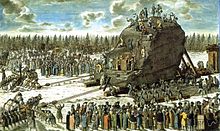The brazen rider
The bronze equestrian statue of Tsar Peter the Great, erected in 1782 on the St. Petersburg Senate Square, is named with the popular name "The Bronze Horseman" ( Russian Медный всадник , Medny wsadnik ) . The equestrian statue is one of the landmarks of Saint Petersburg. Tsar Peter I is depicted “on horseback” on a rearing horse with a snake trampled under its hooves. The scene is supposed to symbolize Peter's victory over the Swedes in the Battle of Poltava .
Empress Catherine the Great had the monument erected by the famous French sculptor Étienne-Maurice Falconet . His student Marie-Anne Collot created the head of the tsar, Fyodor Gordejew the snake. With the monumental memorial, Katharina wanted to give both Peter and herself immortality. It bears the inscription in Latin ("Petro Primo / Catharina Secunda / MDCCLXXXII") on the left and in Russian ("Петру Первому / Екатерина Вторая / Лѣта 1782"; German: "Peter dem Ersten / Katharina the second / 1782") on the right side.
Falconet had followed a call from the tsarina to St. Petersburg in 1766, worked there on the model of the monument from 1768 to 1770, but it was not until 1780 that the huge boulder for the base was brought to St. Petersburg that the 13.60 m was able to rise two years later high monument to be unveiled.
Representation and iconographic type
The ruler is depicted with a laurel wreath , toga and high-tied sandals in an antique-idealizing manner. He sits without stirrups on a hide instead of the saddle that was customary at the time, and his sword has no contemporary model either. The cradling horse continues the rising movement of the monolithic, naturally shaped base.
The motif of the horse standing on its hind legs is a Hellenistic picture invention and was first taken up in post-antiquity by Leonardo da Vinci , but not realized as a sculpture. It was Pietro Tacca who succeeded in realizing such a statically delicate bronze cast in the equestrian monument for Philip IV (1635–1640, Madrid). Gianlorenzo Bernini's equestrian monument to Emperor Constantine , on the other hand, is still technically and compositionally tied to the relief background and his Louis XIV also needed laminated supports.
The monument in St. Petersburg stands at the end of a remarkable tradition of baroque equestrian monuments, which were reserved exclusively for the glorification of rulers. The antique costumes and the gesture of the flat outstretched right hand should be reminiscent of Roman equestrian statues (such as Marcus Aurelius ). But the iconographic type of the dragon slayer St. George (the Russian national saint) is alluded to with the trampled reptile under the horse's hindquarters.
Technical challenges
Transporting the foundation was a technical masterpiece. The monolith called "Donnerstein" (Russian grom-kam ) weighs about 1250 tons and was transported in one piece from the area of Lachta (Finnish Lahti ) about 22 km away on a kind of ball-bearing track and on a boat built for this purpose. The boulder remained at the site near the coast during the Ice Age. Since the excavation was full of water, there has been a small lake (Petersee) at the site. A Russian Orthodox Church was later built in front of it.
The task of moving such a heavy stone was a masterpiece of the engineer Marinos Charvouris in 1780. It was considered to be the heaviest mass moved in one piece up to that point in time. The original boulder weighed almost 2,000 tons and was smoothed a little with charcoal fires. Charvouris had the boulder excavated, devised a kind of car body and had it moved with rope winches and muscle power. The work lasted a whole year. Given the swampy ground in the area, the success of the project was not certain. Contrary to all fears, no people were harmed. The transport process is shown on contemporary illustrations.
There are also extensive descriptions in Russian literature that led to the creation of legends about the monument. A lightning bolt is said to have struck the stone, which is said to have changed the color on its front. In fact, two more boulders were added to simulate the shape of a wave, giving the impression of a crack. The stone wave with the rider symbolizes the conquest of the sea.
Pushkin's poem and the further reception story
After the poem " The Bronze Horseman " (in the Russian original "Медный всадник") by Alexander Pushkin , published in 1833 , which is about this rider and the fight of a little man, the figure got its characteristic nickname. The Pushkin poem is still part of the literary canon in Russian schools today; it is therefore familiar to all Russians. The monument still plays an important role in the cityscape today. Fresh flowers lie at his feet almost all the time, newly married couples come here to celebrate and to have their picture taken in front of him. In 2002 the city administration had the monument restored.
Since 1934 until today it has been the hallmark of Lenfilm (Russian Ленфильм ), one of the largest film studios in Europe based in Saint Petersburg , which was called Leningrad from 1924 to 1991.
See also
Web links
Individual evidence
-
↑ Lexikon der Kunst , Volume 4, Leipzig 1977, p. 81, article Reiterstandbild. For more examples of this type of image seeCommons : Equestrian statues with 2 legs on ground - Collection of images, videos and audio files.
Coordinates: 59 ° 56 ′ 11.6 " N , 30 ° 18 ′ 7.81" E


